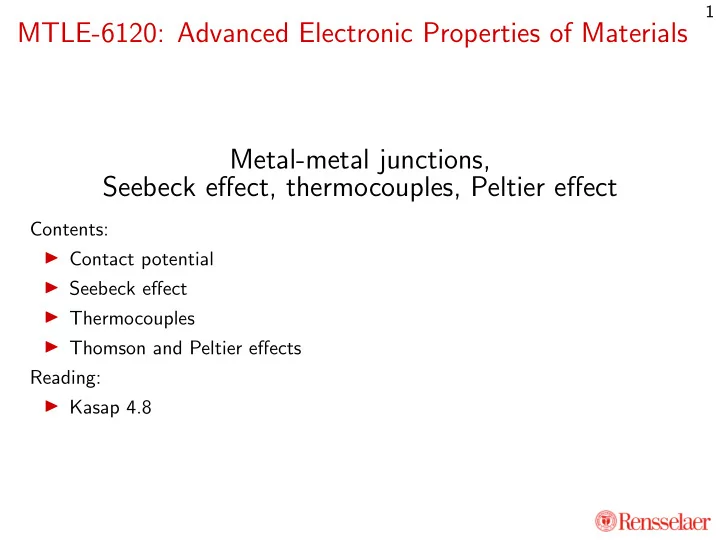

1 MTLE-6120: Advanced Electronic Properties of Materials Metal-metal junctions, Seebeck effect, thermocouples, Peltier effect Contents: ◮ Contact potential ◮ Seebeck effect ◮ Thermocouples ◮ Thomson and Peltier effects Reading: ◮ Kasap 4.8
2 Contact potential + + + - -- Metal 1 Metal 2 Metal 1 Metal 2 ◮ Interface between two metals with different work-functions ◮ Fermi levels at different absolute energies (relative to vacuum) ◮ Is this in equilibrium? ◮ Electrons flow across interface to equalize Fermi-levels (chemical potential) ◮ Bands bend up/down near interface due to potential (on ˚ A scale in metals) ◮ Contact potential at interface e ∆ V = Φ 1 − Φ 2 ◮ Cannot do work: � loop ∆ V = 0 (why?)
3 Seebeck effect E E Cold Hot Temperature, ∆ T E F E F f ( E ) Conductor f ( E ) 0 1 0 1 Voltage ∆ V + – + – + – Hot Cold + – + – ◮ Set up a temperature gradient across a metal ◮ Thermal conductivity: higher E electrons diffuse from hot to cold side ◮ Net electron transfer to cold side ⇒ potential difference opposite ∆ T ◮ Seebeck coefficient: S ( T ) = d V/ d T (expect S < 0 based on above) ◮ Potential difference ∆ V = � S ( T )d T Figure 4.30 from Kasap
4 Seebeck coefficients Metal S ( T = 0C) [ µ V/K] S ( T = 27C) [ µ V/K] E F [eV] x Al -1.6 -1.8 11.6 2.78 Mg -1.3 7.1 1.38 Au +1.79 +1.94 5.5 -1.48 Cu +1.70 +1.84 7.0 -1.79 ◮ Intuitive argument ⇒ S < 0 , but metals exhibit both signs ◮ Mott-Jones equation defines x above: S ≈ − π 2 k 2 B T d x with x ≡ E F ln σ ( E F ) 3 eE F d E F where σ ( E F ) is the electronic conductivity at a given E F ◮ Positive S ⇒ σ ↑ as E F ↓ (or higher σ below Fermi level than above) ◮ What does the sign of the Seebeck coefficient mean?
5 Thermocouple Al Al Hot Cold Hot 0 ° C 0 ° C Cold 100 ° C 100 ° C 0 0 Al Al Ni Ni V V ◮ In closed loop in single metal: V = 0 � T hot ◮ If two junctions at different temperature: ∆ V = T cold d TδS ( T ) where ∆ S is difference between Seebeck coefficients in two materials ◮ Most common method of measuring temperature in lab ◮ Materials with high enough Seebeck coefficients: electrical energy harvesting from k B T ! Figure 4.32 from Kasap
6 Thomson and Peltier effects ◮ Pass current density � j through material with temperature gradient ∇ T generates heat per unit volume q = −K � ˙ j · ∇ T with Thomson coefficient K = T d S/ d T ◮ Flow current I across a metal-metal junction produces heat at rate: ˙ Q = (Π 1 − Π 2 ) I where Π 1 / 2 = TS 1 / 2 is the Peltier coefficient ◮ Basically the opposite of the Seebeck effect: charge flow generates thermal gradient ◮ In current loop with two metals: heat extracted in one junction, dissipated in other ⇒ refrigeration! ◮ Solid-state cooling using Peltier effect replacing LN2 in many cryo systems ◮ All solid-state superconducting devices combining Peltier coolers with high T c superconductors!
Recommend
More recommend